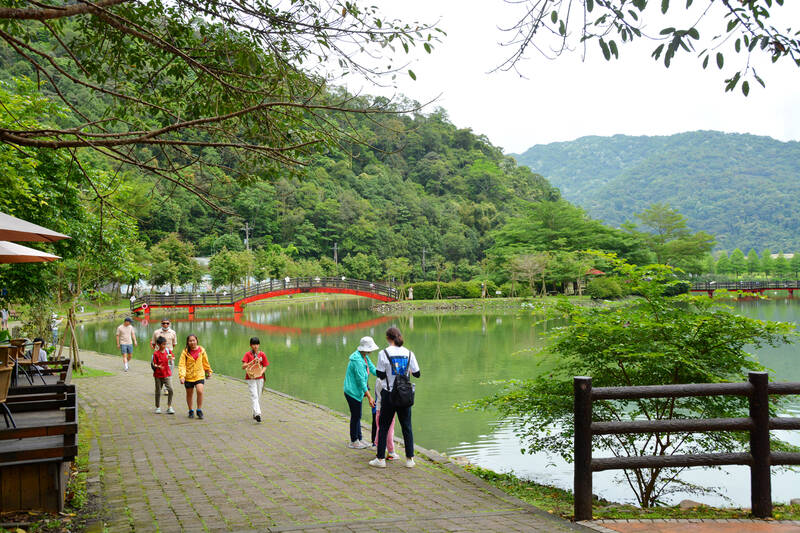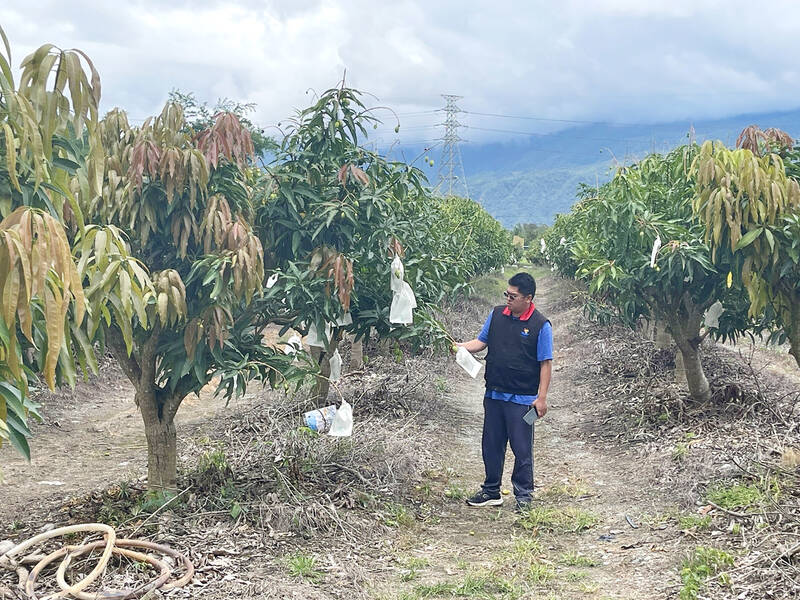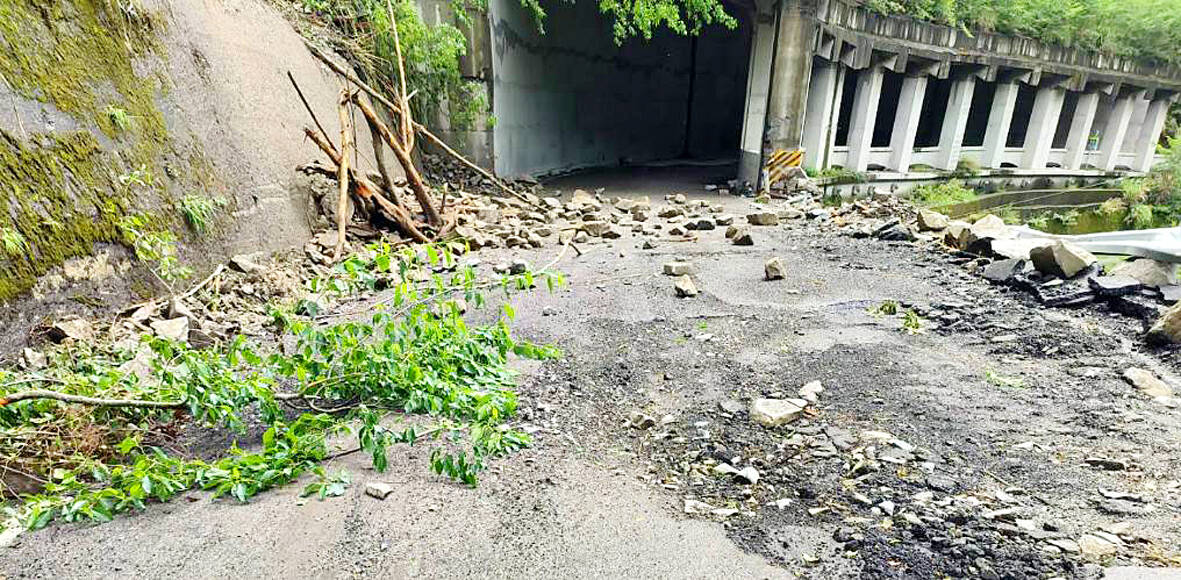On Facebook a friend posted a dashcam video of a vehicle driving through the ash-colored wasteland of what was once Taroko Gorge. A crane appears in the video, and suddenly it becomes clear: the video is in color, not black and white.
The magnitude 7.2 earthquake’s destruction on April 3 around and above Taroko and its reverberations across an area heavily dependent on tourism have largely vanished from the international press discussions as the news cycle moves on, but local residents still live with its consequences every day. For example, with the damage to the road corridors between Yilan and Hualien, the traveling public has shifted to rail as its preferred mode of transport. Both travelers and administrators have to make constant adjustments to this new reality, lengthening travel times and raising costs. The road damage has also forced all trucked in supplies to travel around the southern end of the island of Taiwan and up Highway 11.
LOST ECONOMIC ACTIVITY

Photo: Wang Chun-chi, Taipei Times
The quake has also pushed other issues out of the news. It came on the heels of an abnormally cool March, the pollination season for southern Hualien’s mango crop, among others. In Yuli (玉里) and Jhuosi (卓溪) townships in some areas production fell 30 percent and local farmers are applying for assistance. The local governments have been organizing exhibitions of Hualien agricultural products elsewhere in Taiwan to help local farmers, hard hit by the quake.
Long-term shifts are driving rising costs of living on the coast. As people move out of the cities in search of less pressured environments, house prices are rising. Places to rent are difficult to find. Laborers for routine tasks like laying cement and putting in electric lights are more expensive, since many of the best workers, according to the locals, have moved over to the other coast where the money is better. The quake has put even more pressure on local workers.
Ease of access has meant that images coming out of the quake-stricken areas were largely of the two dramatically affected buildings in Hualien city, and a few videos of roads in Taroko. Images of the destruction of the trails in and above the park, along with local places to stay and associated infrastructure, are hard to find even in local papers.

Photo courtesy of the Hualien County Government
According to reports, numerous tourist sites were destroyed. For example, large rocks fell on the huts at Buluowan (布洛灣山月村) and destroyed its water supply. The current operator was forced to terminate its contract because the site could no longer be operated. Many popular trails were knocked out, as a glance at Google maps will show.
All that economic activity is now lost. Many of the communities suffering the most are indigenous communities.
In early April, a few days after the quake, the Hualien Tourism Council announced that Hualien would lose NT$5.3 billion. The head of the organization said they expected hotel bookings to fall by 90 percent. The hit was worse than normal, because the quake occurred on the four-day Tomb Sweeping Holiday.

Photo courtesy of the Directorate General of Highways
The economic effect is actually far greater and more pervasive than suggested by the Hualien Tourism Council. The $5.3 billion figure was calculated by multiplying tourist spending in Hualien per hotel-room day, NT$5,700, by the 17,000 hotel rooms in the county. Day trips and tours from Taipei to Taroko are also gone. As cash flows dry up to local restaurants and service outlets, locals will able spending less money.
Hualien remains a major tourist destination. Though it is easy to think that the problems will be limited to Taroko, in reality, with access substantially more difficult, the hit will be felt across the county and further south. A friend who works closely with indigenous communities in developing indigenous tourism just returned from Taitung, where she told me tourism has taken a substantial blow.
The trucks on Highway 11 are already reducing the bike tour groups, according to friends of mine in the area. There will also be secondary effects like a general downturn in people taking mountain vacations and trips to Hualien out of fear of quakes. That will recover in time.
On May 2 the cabinet cobbled together a budget from various central and local government funds for repairs and rebuilding totaling NT$28.55 billion. The budget also supports installation of earthquake sensors and safety equipment at Chongde and Heren stations in Hualien (incredibly, they did not have them before this quake despite frequent quakes in the area).
HEAD TO HUALIEN
This will help locals, but they need us to get out to the east coast and spend. If rail tickets are hard to get, remember that Taitung airport is an hour by plane from Taipei’s Songshan Airport. The quake last month was the latest in a long string of problems that have pounded the tourism industry in Hualien, dating back to the 2018 quake, which was followed by the pandemic.
Meanwhile, the quake’s effect on communications between Hualien and points north is bound to be harnessed by the Chinese Nationalist Party (KMT) in its quest to put in a highway through the rift valley, another from the east coast to the west coast, and an HSR line down the east coast and around the island.
I have argued elsewhere that a key purpose of KMT-supported large project spending is reducing funding available for defense (“Taiwan’s construction-industrial money pit”, April 8, 2024). But the quake’s highlighting of communication issues should suggest to defense planners — and potential foes — that east coast communications could be easily interdicted in a conflict, especially as new and more capable drones come online (recall that one of the nation’s most important airbases is in Hualien, south of that bottleneck).
Instead of spending money on highways that will blight the Rift Valley and the mountains and be damaged or blocked in major quakes, the government could use the quake to promote hardening and expansion of the ports on the east coast — which Taiwan will need if supplies are to schlepped up from Philippines in a conflict and some judicious hardening and perhaps expansion of the Yilan-Hualien road connections.
In the meantime, go there and spend. The people need it.
Notes from Central Taiwan is a column written by long-term resident Michael Turton, who provides incisive commentary informed by three decades of living in and writing about his adoptive country. The views expressed here are his own.

On April 26, The Lancet published a letter from two doctors at Taichung-based China Medical University Hospital (CMUH) warning that “Taiwan’s Health Care System is on the Brink of Collapse.” The authors said that “Years of policy inaction and mismanagement of resources have led to the National Health Insurance system operating under unsustainable conditions.” The pushback was immediate. Errors in the paper were quickly identified and publicized, to discredit the authors (the hospital apologized). CNA reported that CMUH said the letter described Taiwan in 2021 as having 62 nurses per 10,000 people, when the correct number was 78 nurses per 10,000

As we live longer, our risk of cognitive impairment is increasing. How can we delay the onset of symptoms? Do we have to give up every indulgence or can small changes make a difference? We asked neurologists for tips on how to keep our brains healthy for life. TAKE CARE OF YOUR HEALTH “All of the sensible things that apply to bodily health apply to brain health,” says Suzanne O’Sullivan, a consultant in neurology at the National Hospital for Neurology and Neurosurgery in London, and the author of The Age of Diagnosis. “When you’re 20, you can get away with absolute

May 5 to May 11 What started out as friction between Taiwanese students at Taichung First High School and a Japanese head cook escalated dramatically over the first two weeks of May 1927. It began on April 30 when the cook’s wife knew that lotus starch used in that night’s dinner had rat feces in it, but failed to inform staff until the meal was already prepared. The students believed that her silence was intentional, and filed a complaint. The school’s Japanese administrators sided with the cook’s family, dismissing the students as troublemakers and clamping down on their freedoms — with

As Donald Trump’s executive order in March led to the shuttering of Voice of America (VOA) — the global broadcaster whose roots date back to the fight against Nazi propaganda — he quickly attracted support from figures not used to aligning themselves with any US administration. Trump had ordered the US Agency for Global Media, the federal agency that funds VOA and other groups promoting independent journalism overseas, to be “eliminated to the maximum extent consistent with applicable law.” The decision suddenly halted programming in 49 languages to more than 425 million people. In Moscow, Margarita Simonyan, the hardline editor-in-chief of the